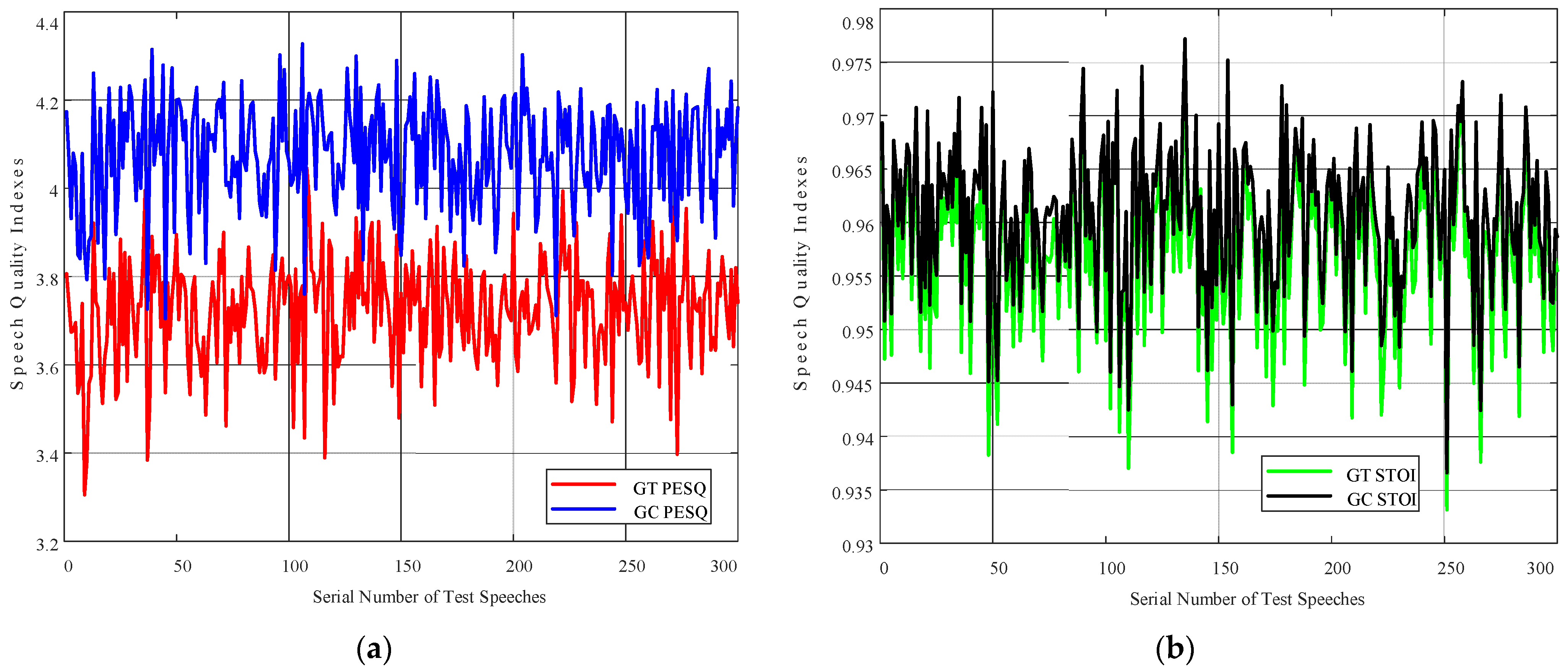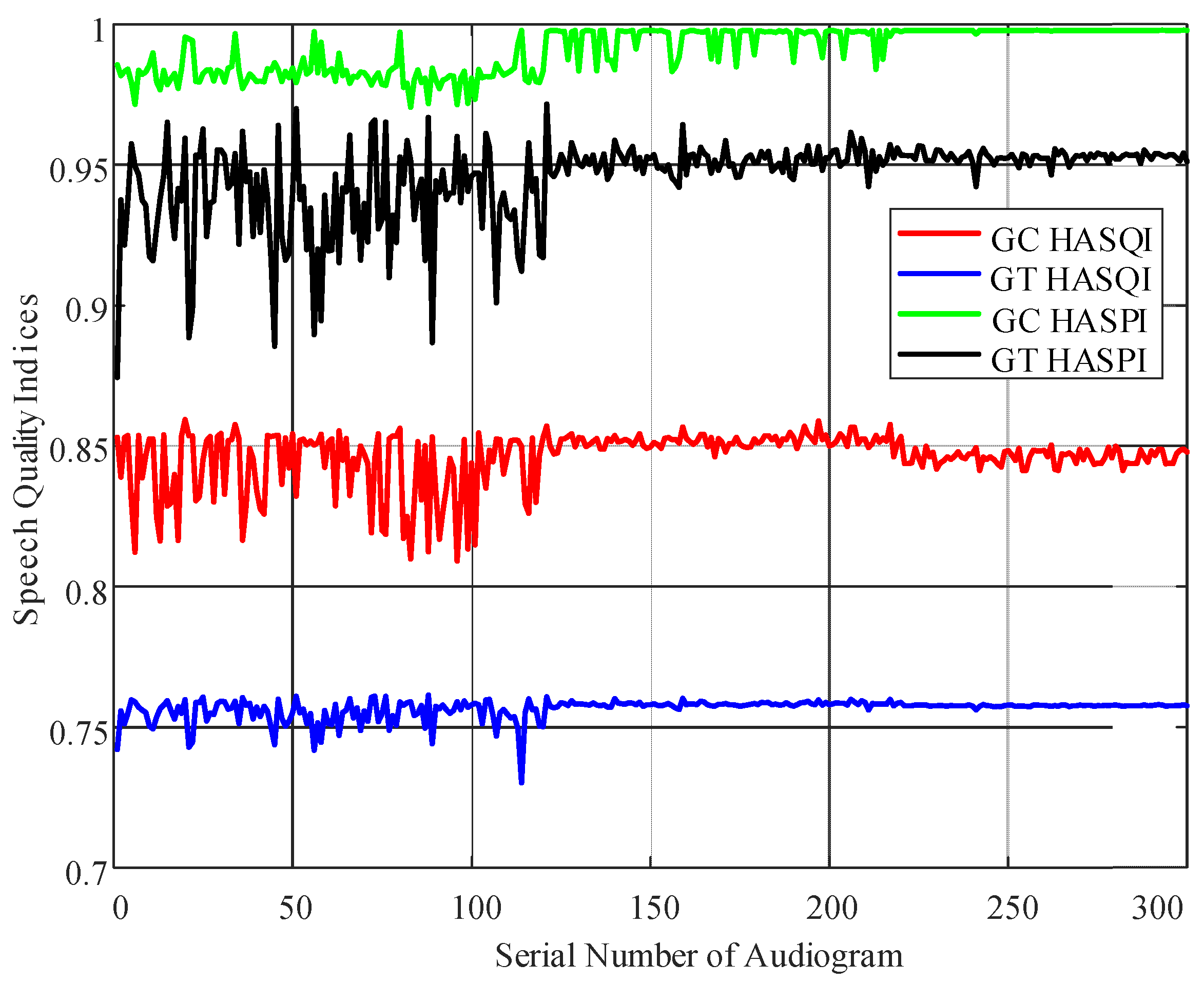A Design Method for Gammachirp Filterbank for Loudness Compensation in Hearing Aids
Abstract
:1. Introduction
- We applied the gammachirp filterbank as a component in the loudness compensation system. The filter parameters were calculated based on the human auditory characteristics and the intensity of the input signal. The obtained multichannel gammachirp filterbanks model the frequency selectivity characteristics of the human ear;
- We introduced a new method of channel combination to reduce the computational complexity. The adjacent channels were merged by the characteristics of the special audiogram and the relationship between frequency ranges and speech intelligibility. After obtaining the personalized filterbank, each band carried out loudness compensation, based on the curve provided by the hearing-impaired patients;
- We conducted an objective evaluation and subjective assessment experiments. The results illustrate that the proposed method can considerably improve sentence intelligibility. The input speech can be reconstructed with fewer channels and satisfy different audiogram matching requirements.
2. Design of Gammachirp Filterbank
3. Channel Division Method
4. Experiments and Discussion
4.1. Effect of Chirp Factor on Gammachirp Filter
4.2. Comparison of Speech Quality of the Reconstructed Signals
4.3. Loudness Compensation Experiment
4.3.1. Objective Evaluation
4.3.2. Subjective Assessment
5. Conclusions
Author Contributions
Funding
Institutional Review Board Statement
Informed Consent Statement
Data Availability Statement
Conflicts of Interest
References
- Liang, R.; Guo, R.; Xi, J.; Xie, Y.; Zhao, L. Self-Fitting Algorithm for Digital Hearing Aid Based on Interactive Evolutionary Computation and Expert System. Appl. Sci. 2017, 7, 272. [Google Scholar] [CrossRef] [Green Version]
- Ruwei, L.I.; Cao, L.; Bao, C.; Shuicai, W.U. Loudness compensation algorithm based on Gammatone filter bank decomposition for digital hearing aid. Beijing Biomed. Eng. 2016, 35, 143–150. [Google Scholar]
- Tran, L.; Schepker, H.; Doclo, S.; Hai, H.D.; Nordholm, S. Improved Practical Variable Step-Size Algorithm for Adaptive Feedback Control in Hearing Aids. In Proceedings of the International Conference on Signal Processing and Communication Systems, Gold Coast, QLD, Australia, 19–21 December 2016; IEEE: New York, NY, USA, 2017. [Google Scholar]
- Park, G.; Cho, W.; Kim, K.-S.; Lee, S. Speech Enhancement for Hearing Aids with Deep Learning on Environmental Noises. Appl. Sci. 2020, 10, 6077. [Google Scholar] [CrossRef]
- Ma, T.; Shen, C.; Wei, Y. Adjustable filter bank design for hearing AIDS systemz. In Proceedings of the 2019 IEEE International Symposium on Circuits and Systems(ISCAS), Sapporo, Japan, 26–29 May 2019; IEEE: New York, NY, USA, 2019. [Google Scholar]
- Li, H.; Jullien, G.A.; Dimitrov, V.S.; Ahmadi, M.; Miller, W. A 2-digit multidimensional logarithmic number system filterbank for a digital hearing aid architecture. In Proceedings of the 2002 IEEE International Symposium on Circuits and Systems, Proceedings (Cat. No.02CH37353). Phoenix-Scottsdale, AZ, USA, 26–29 May 2002; IEEE: New York, NY, USA, 2002. [Google Scholar]
- Onat, E.; Ahmadi, M.; Jullien, G.A.; Miller, W.C. Optimized Delay Characteristics for a Hearing Instrument Filter Bank. In Proceedings of the IEEE Midwest Symposium on Circuits & Systems, Lansing, MI, USA, 8–11 August 2000; IEEE: New York, NY, USA, 2002. [Google Scholar]
- Parameshappa, G.; Jayadevapp, D. Efficient uniform digital filter bank with linear phase and FRM technique for hearing aids. Int. J. Eng. Technol. 2018, 7, 69–74. [Google Scholar] [CrossRef] [Green Version]
- Wei, Y.; Wang, Y. Design of Low Complexity Adjustable Filter Bank for Personalized Hearing Aid Solutions. IEEE/ACM Trans. Audio Speech Lang. Process. 2015, 23, 923–931. [Google Scholar] [CrossRef]
- Wei, Y.; Ma, T.; Ho, B.K.; Lian, Y. The Design of Low-Power 16-Band Nonuniform Filter Bank for Hearing Aids. IEEE Trans Biomed. Circuits Syst. 2019, 13, 112–123. [Google Scholar] [CrossRef]
- Amir, A.; Bindiya, T.S.; Elizabeth, E. Design and implementation of reconfigurable filter bank structure for low complexity hearing aids using 2-level sound wave decomposition. Biomed. Signal. Process. Control 2018, 43, 96–109. [Google Scholar]
- Bao, F.; Abdulla, W.H. Noise masking method based on an effective ratio mask estimation in Gammatone channels. APSIPA Trans. Signal Inf. Process. 2018, 7, 1–12. [Google Scholar] [CrossRef] [Green Version]
- Saleem, N.; Ijaz, G. Low rank sparse decomposition model based speech enhancement using gammatone filterbank and Kullback–Leibler divergence. Int. J. Speech Technol. 2018, 21, 217–231. [Google Scholar] [CrossRef]
- Onizawa, N.; Koshita, S.; Sakamoto, S.; Kawamata, M.; Hanyu, T. Design of Stochastic Asymmetric Compensation Filters for Auditory Signal Processing. In Proceedings of the 2017 IEEE Global Conference on Signal and Information Processing, Montreal, QC, Canada, 14–16 November 2017; IEEE: New York, NY, USA, 2017; pp. 1315–1319. [Google Scholar]
- Abid, K.; Ouni, K.; Ellouze, N. Audio Compression Codec Using a Dynamic Gammachirp Psychoacoustic Model And a D.W.T Multiresolution Analysis. Int. J. Comput. Sci. Eng. 2010, 2, 1340–1354. [Google Scholar]
- Ouni, K.; Ellouze, N. Fitting Gammachirp filter model parameters to perceptual second formant data of voiced speech. In Proceedings of the IMACS Multiconference on Computational Engineering in Systems Applications (CESA 2006), Beijing, China, 4–6 October 2006; Sun, F., Liu, H.P., Eds.; IEEE: New York, NY, USA, 2007; pp. 260–264. [Google Scholar]
- Salhi, L. Design and Implementation of the Cochlear Filter Model Based on a Wavelet Transform as Part of Speech Signals Analysis. Res. J. Appl. Sci. 2007, 2, 512–521. [Google Scholar]
- Liu, Y.; He, L.; Liu, J. Improved Multitaper PNCC Feature for Robust Speaker Verification. In Proceedings of the 2014 9th International Symposium on Chinese Spoken Language Processing, New York, NY, USA, 12–14 September 2014; Dong, M., Tao, J., Li, H., Zheng, T.F., Lu, Y., Eds.; IEEE: New York, NY, USA, 2014; pp. 168–172. [Google Scholar]
- Alam, M.J.; Kenny, P.; O’Shaughnessy, D. Robust feature extraction based on an asymmetric level-dependent auditory filterbank and a subband spectrum enhancement technique. Digit. Signal Process. 2014, 29, 147–157. [Google Scholar] [CrossRef]
- Zhang, H.; Zhang, X.; Gao, G. Training Supervised Speech Separation System to Improve STOI and PESQ Directly. In Proceedings of the 2018 IEEE International Conference on Acoustics, Speech, and Signal Processing, ICASSP 2018, Calgary, AB, Canada, 15–20 April 2018; IEEE: New York, NY, USA, 2018; pp. 5374–5378. [Google Scholar]
- Olatubosun, A.; Olabisi, P.O. An Improved Logistic Function for Mapping Raw Scores of Perceptual Evaluation of Speech Quality (PESQ). J. Eng. Res. Rep. 2018, 3, 1–10. [Google Scholar] [CrossRef]
- Sharma, B.; Wang, Y. Automatic Evaluation of Song Intelligibility Using Singing Adapted STOI and Vocal-Specific Features. IEEE/ACM Trans. Audio Speech Lang. Process. 2020, 28, 319–331. [Google Scholar] [CrossRef]
- Kates, J.M.; Arehart, K.H. The Hearing-Aid Speech Perception Index (HASPI). Speech Commun. 2014, 65, 75–93. [Google Scholar] [CrossRef]
- Zhang, Z.; Shen, Y.; Williamson, D.S. Objective Comparison of Speech Enhancement Algorithms with Hearing Loss Simulation. In Proceedings of the 2019 IEEE International Conference On Acoustics, Speech And Signal Processing (ICASSP), Brighton, UK, 12–17 May 2019. [Google Scholar]
- Keidser, G.; Dillon, H.R.; Flax, M.; Ching, T. The NAL-NL2 prescription procedure. Audiol. Res. 2011, 1, 88–90. [Google Scholar] [CrossRef] [Green Version]
- Scollie, S. The Desired Sensation Level multistage input/output algorithm. Trends Amplif. 2005, 9, 159. [Google Scholar] [CrossRef] [Green Version]
- Killion, M.C. Loudness-data basis for ‘‘FIG6’’ hearing-aid fitting targets. J. Acoust. Soc. Am. 1995, 98, 2927. [Google Scholar] [CrossRef] [Green Version]
- Kumar, A.; Singh, G.K.; Anurag, S. An optimized cosine-modulated nonuniform filter bank design for subband coding of ECG signal. J. King Saud Univ. Eng. Sci. 2015, 27, 158–169. [Google Scholar] [CrossRef] [Green Version]
- Irino, T.; Patterson, R.D. A compressive gammachirp auditory filter for both physiological and psychophysical data. J. Acoust. Soc. Am. 2001, 109, 2008–2022. [Google Scholar] [CrossRef]
- Irino, T.; Patterson, R.D. A Dynamic Compressive Gammachirp Auditory Filterbank. IEEE Trans. Audio Speech Lang. Process. 2006, 14, 2222–2232. [Google Scholar] [CrossRef] [PubMed] [Green Version]
- Unoki, M.; Irino, T.; Patterson, R.D. Improvement of an IIR asymmetric compensation gammachirp filter. Acoust. Sci. Technol. 2001, 22, 426–430. [Google Scholar] [CrossRef] [Green Version]
- Patterson, R.D.; Unoki, M.; Irino, T. Extending the domain of center frequencies for the compressive gammachirp auditory filter. J. Acoust. Soc. Am. 2003, 114, 1529–1542. [Google Scholar] [CrossRef] [PubMed]
- Cusack, R.; Carlyon, R.P. Perceptual asymetries in audition. J. Exp. Psychol. Hum. Percept. Perform. 2003, 29, 713–725. [Google Scholar] [CrossRef] [Green Version]
- Cao, L.T.; Li, R.W.; Shi, Y.Q.; Wang, S.; Xie, D.; Yang, R.; Sun, J.; Wang, L.; Hui, X.; Chen, Y. Loudness Compensation Method Based On Human Auditory For Digital Hearing Aids. In Proceedings of the 2014 7th International Conference on Biomedical Engineering and Informatics, Dalian, China, 14–16 October 2014; IEEE: New York, NY, USA, 2015. [Google Scholar]
- Wang, Q.Y. A Multichannel Loudness Compensation Method for Digital Hearing Aids. J. Electron. Inf. Technol. 2009, 31, 832–835. [Google Scholar]
- Wang, Q.Y.; Liang, R.Y.; Rahardja, S.; Zhao, L.Y.; Zou, C.R.; Zhao, L. Piecewise-Linear Frequency Shifting Algorithm for Frequency Resolution Enhancement in Digital Hearing Aids. Appl. Sci. 2017, 7, 335. [Google Scholar] [CrossRef]
- Zhang, H. Hearing Aids; People’s Medical Publishing House: Shelton, CT, USA, 2004. [Google Scholar]
- Masterson, E.A.; Deddens, J.A.; Themann, C.L.; Bertke, S.; Calvert, G.M. Trends in worker hearing loss by industry sector, 1981-2010. Am. J. Ind. Med. 2015, 58, 392–401. [Google Scholar] [CrossRef] [Green Version]
- Smith, A. Preventing deafness—An achievable challenge. The WHO perspective. Int. Congr. Ser. 2003, 1240, 183–191. [Google Scholar] [CrossRef]











| Frequency Range (Hz) | Intelligibility (%) |
|---|---|
| 0–250 | 2 |
| 250–500 | 3 |
| 500–1000 | 35 |
| 1000–2000 | 35 |
| 2000–4000 | 13 |
| 4000–8000 | 12 |
| Index | Number of Channels | Gammatone Filterbanks | Gammachirp Filterbanks | ||
|---|---|---|---|---|---|
| Mean | Variance | Mean | Variance | ||
| PESQ | 8-channels | 3.7532 | 0.0117 | 4.0126 | 0.0118 |
| 4-channels | 3.7233 | 0.0148 | 4.0742 | 0.0153 | |
| STOI | 8-channels | 0.9606 | 3.4580 × 10−5 | 0.9701 | 2.603 × 10−5 |
| 4-channels | 0.9574 | 5.3106 × 10−5 | 0.9604 | 4.4718 × 10−5 | |
| SPL (dB) | The Recognition Rate of the Original Speech (%) | The Recognition Rate of Compensation Signal Based on Gammatone Filterbank (%) | The Recognition Rate of Compensation Signal Based on Gammachirp Filterbank (%) |
|---|---|---|---|
| 10 | 0 | 0 | 0 |
| 20 | 0 | 0 | 0 |
| 30 | 0 | 4 | 16 |
| 40 | 10 | 12 | 22 |
| 50 | 32 | 38 | 46 |
| 60 | 58 | 68 | 76 |
| 70 | 68 | 80 | 88 |
Publisher’s Note: MDPI stays neutral with regard to jurisdictional claims in published maps and institutional affiliations. |
© 2022 by the authors. Licensee MDPI, Basel, Switzerland. This article is an open access article distributed under the terms and conditions of the Creative Commons Attribution (CC BY) license (https://creativecommons.org/licenses/by/4.0/).
Share and Cite
Guo, R.; Liang, R.; Wang, Q.; Zou, C. A Design Method for Gammachirp Filterbank for Loudness Compensation in Hearing Aids. Appl. Sci. 2022, 12, 1793. https://doi.org/10.3390/app12041793
Guo R, Liang R, Wang Q, Zou C. A Design Method for Gammachirp Filterbank for Loudness Compensation in Hearing Aids. Applied Sciences. 2022; 12(4):1793. https://doi.org/10.3390/app12041793
Chicago/Turabian StyleGuo, Ruxue, Ruiyu Liang, Qingyun Wang, and Cairong Zou. 2022. "A Design Method for Gammachirp Filterbank for Loudness Compensation in Hearing Aids" Applied Sciences 12, no. 4: 1793. https://doi.org/10.3390/app12041793
APA StyleGuo, R., Liang, R., Wang, Q., & Zou, C. (2022). A Design Method for Gammachirp Filterbank for Loudness Compensation in Hearing Aids. Applied Sciences, 12(4), 1793. https://doi.org/10.3390/app12041793






